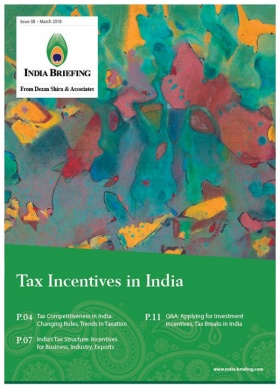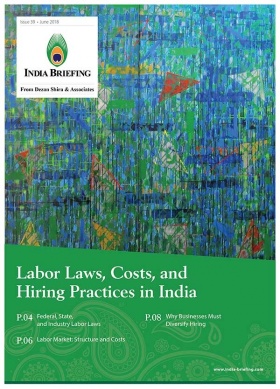India, South Korea Trade and Investment Ties: Focus on CEPA, Make in India
South Korean President Moon Jae-in undertook a four-day visit to India in early July, keen to improve bilateral economic and business ties between Seoul and New Delhi.
High on the visiting leader’s agenda was renewing South Korean interest in Prime Minister Narendra Modi’s flagship ‘Make in India‘ campaign.
Moon and Modi were both present as Samsung, the South Korean multinational conglomerate, used the visit to launch its largest global mobile factory in Delhi’s National Capital Region.
After formal talks, the focus was on finding ways to ease bilateral investment challenges, deepen economic ties, and upgrade the current Comprehensive Economic Partnership Agreement (CEPA).
India and South Korea also aim to increase trade and investment to US$50 billion by 2030 – from the current US$20 billion.
Converging Moon’s ‘New Southern Policy’ with Modi’s ‘Act East’
MoUs were signed to boost bilateral trade and investment and promote cooperation across a wide spectrum – artificial intelligence, biotechnology, railways, culture, and tourism, among others.
Overall, the MoUs reflect the complementary foreign policy agendas of India and South Korea – Modi’s ‘Act East’ and Moon’s ‘New Southern Policy’.
The New Southern Policy focuses on economic cooperation and building a prosperous and people-centric community of peace in the South Asian region.
India’s Act East policy encourages further economic engagement, reinvigorating cultural and tourism relations, and developing new strategic partnerships with countries in the Indo-Pacific region.
Both the policies converge in their directives, which will reinforce trade and investment ties through CEPA – the bilateral trade agreement in force since 2009.
India-Korea CEPA – Harvest deal negotiated
Modi and Moon have urged business communities in both countries to take advantage of the complementary requirements of the two economies and enhance the benefits available under CEPA .
The two countries signed a joint statement on July 10 upgrading negotiations under CEPA, with early harvest offers made for 35 items.
In addition, yoga and taekwondo instructors were included in the list of professionals under the Sporting and Other Recreational Services category. This means Indians can now open yoga institutes in South Korea and Koreans can open taekwondo institutes in India under the Early Harvest Package (EHP).
South Korea also agreed to eliminate tariffs over a period of time on 17 Indian products – seven fish items, beer, jams and jellies, mango, corn, and maize, among others. In particular, South Korea will reduce the import tariff on shrimps from 20 percent to zero upfront for 15,000 tons; India’s total marine exports currently stands at 2,400 tons.
India will, in turn, reduce / eliminate import tariffs for 11 items, including fish fillets and marine base oil.
With regards to the movement of professionals, the EHP increases the visa duration for information communication technology (ICT) employees to three years from one year.
These changes will move some way in correcting the trade balance between the two countries – South Korea enjoyed a trade surplus of US$12 billion in 2017-18.
Bilateral trade and investment scenario
South Korea has a stronghold in the global electronics market, also reflected in its trade with India. Electronics and electrical equipment dominated Indian imports from South Korea in 2017 – accounting for US$3.09 billion (Rs 211.7 billion).
India, on the other hand, exports raw goods, such as aluminum, iron and steel, organic chemicals, as well as machinery.
South Korea’s business environment, much like India’s, depends largely on major family run mega-conglomerates or ‘chaebols’. Samsung, Hyundai, and LG are a few that have already made large investments in India. Indian firms in South Korea mostly belong to the IT services and consultancy category.
Several manufacturing sectors benefit from strong bilateral ties between India and South Korea – from automobiles and engineering to consumer goods.
India’s competitive labor market and ‘Make in India’ policy provides South Korean companies with the impetus to invest in manufacturing here.
Further, the newly set up Korea-India Future Vision Strategy Group will identify areas of high-end technological components to boost trade and investments between the two countries.
This focus on investing and knowledge exchange in developing leapfrog technologies will open up business opportunities across several rapidly expanding sectors, including biotechnology, cyber security, healthcare, and energy.
Around 150 Korean companies from the automotive, heavy industry, food processing, and textiles sectors have shown interest in setting up in India in the coming years.
The Indian government’s ‘Korea Plus’ initiative is largely responsible for this.
Under this initiative, a Korea desk has been set up within the government and acts as the first point of reference for Korean companies interested in market access to India.
They assist in end-to-end services such as public relations, market or project research, and provide business intelligence services to Korean companies investing in India.
Investment prospects in electronics, infrastructure industries
India’s electronics manufacturing sector is growing at 17 percent CAGR; it is expected to cross US$228 billion (Rs 15.6 trillion) in turnover by 2020.
The electronics manufacturing services (EMS) segment has also seen rapid growth over the past few years, doubling from US$500 million (Rs 34.25 billion) in 2013 to US$1 billion (Rs 68.5 billion) in 2015. Both sectors are a stronghold for Korean manufacturers.
With the ‘Make in India’ policy offering incentives for foreign companies manufacturing in India and a push to increase the number of electric vehicles on Indian roads – Korean investors will find a large market in India for a wide range of products from lithium batteries to electronic components to IoT in the coming years.
India’s infrastructure industry is also growing at a fast pace, with foreign investor interest keen on roads, transmission and telecommunications, and renewable energy sectors.
Currently the foreign investment landscape in this area is dominated by global pension funds, large private equity (PE) players, and long-term capital investors as well as investments from the UAE and Japan.
China, Thailand, and Malaysia are other countries bullish on India’s infrastructure market – identifying marquee projects and Indian manufacturing equipment, power, and construction companies for investment.
As India hurries to upgrade its infrastructure to match the standards of advanced economies and regional rivals, South Korean firms with long-standing experience in the sector will stand to benefit.
Meanwhile, the Export-Import Bank of Korea is pursuing a US$10 billion (Rs 685 billion) plan to support infrastructure development across India.
About Us
India Briefing is produced by Dezan Shira & Associates. The firm assists foreign investors throughout Asia and maintains offices in China, Hong Kong, Indonesia, Singapore, Vietnam, and Russia.
Please contact india@dezshira.com or visit our website at www.dezshira.com.
- Previous Article India’s Presumptive Taxation Scheme: SMEs and Professionals Key Beneficiaries
- Next Article HR Management in the Digital Workplace: Tips for Employers in India
















